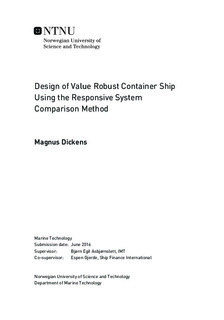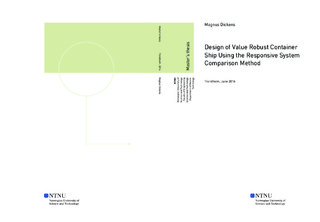| dc.description.abstract | Traditionally the conceptual design phase of ships has focused on the technical analysis - the mapping from the design to the performance space. The performance of the vessel does not fully capture the value of the vessel, and it becomes necessary to perform a mapping from the performance to a value space. Static performance and value models are not suffi-cient to perform proper evaluation of a design in the early stages. There are likely to be major changes in the operating context of the vessel during its lifecycle, which will greatly influence the performance and value. The quality of a new vessel from the perspective of the ship owner is strongly associated with value robustness of the design. Value robustness is defined as the ability of a system to continue to deliver stakeholder value in the face of shifts in context and needs.
This thesis investigates strategies to expand the boundaries of conceptual ship design. The overall goal has been to examine approaches to handle contextual uncertainties with the goal of achieving value robust designs of transportation vessels.
We present an introduction to conceptual ship design, were the state of the art and motiva-tion for the research questions are presented. We further address the perception of value in ship design, and the influence of uncertainties. This is related to systems engineering ap-proaches to handle complexity in design, and Epoch-Era and the Responsive Systems Comparisons (RSC) method are introduced.
In a case study the RSC method is used as framework for including Epoch-Era Analysis with traditional design methodologies. The basis for the case study is the container market. The case study incorporates some factors specific to the container industry, including the organization of liner services. The general approach demonstrated in the case study are believed to be applicable for most segments of merchant transportation vessels.
We measure the utility as a combination of an objective measure of monetary transporta-tion cost and stakeholder perception of the value of operational flexibility. The number of ports capable of servicing the vessel is used as the basis for assessing the operational flexi-bility. We develop a cost model to calculate the building cost and capital expenditures, the operational cost and the fuel based voyage expenditures as a function of the design deci-sions and market situation. The primary datasource is several databases of ship particulars and historic market development. Regression analysis and other statistical methods are used to construct a model to perform the tradespace exploration and the form-function-value mapping. The model is used to evaluate the designspace across changing context to calculate a robust utility value. The Pareto front of the resulting value space identifies po-tential value robust design configurations.
Multi-Epoch design space evaluation
The model shows the ability to predict real-life observations and is to a certain degree aligned with findings of other research. The model is strongly influenced by assumptions made based on limited information.
To our knowledge, this is the first attempt to combine the Responsive Systems Compari-son method with Epoch-Era analysis to address the value robustness of transportation ves-sels. We believe the method developed is an interesting take to expand the boundaries of conceptual design of merchant vessels that can be used as a basis for further research and development. | |

